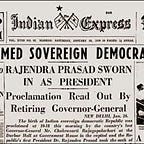The National Identity XXIV: Karnataka’s Identity Crisis
Why a linguistic division of the South still left it with a muddled identity
The Indian Constitution doesn’t allow its States to have their own flags. Yet, you couldn’t have spent any amount of time in Bangalore without noticing the distinctive red and yellow flag with the state border etched in the center. Its origins are as a flag of a political party, the Kannada Paksha, however it has been co-opted for all manners of Kannada sub-nationalism. The flags, and their bearers, come out in full force after every Cauvery verdict, every Bandh (the Bandh usually follows the verdict) and every Rajyostava. For all the noise about not even being Constitutional, they also hang on an awful lot of street corners.
The flag’s flaunting has its origins in the historical insecurity that Karnataka suffers from. Potti Sriramulu led the march to gain statehood for Andhra Pradesh in 1954. He, literally, fasted unto death. Andhra Pradesh, in 1956, became the first state to be born along linguistic lines — escaping the clutches of the ‘dominant’ Tamil language and culture, which dominated the British South India. This…
